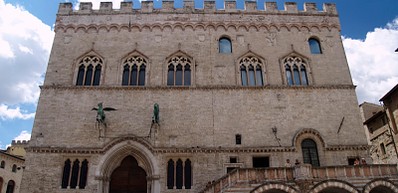
-
![Arch of Etruscans (Augustus Arch) in Perugia, Umbria]() Provided by: Shchipkova Elena/Shutterstock.com
Provided by: Shchipkova Elena/Shutterstock.com

Our travel guides are free to read and explore online. If you want to get your own copy, the full travel guide for this destination is available to you offline* to bring along anywhere or print for your trip.
*this will be downloaded as a PDF.Price
€4,95
Etruscan Arches
The guide was updated:Six of the seven original Etruscan arches into the city can still be seen, with Roman, Medieval and Renaissance alterations. Take a walk around the city following the original walls – the tourist office in Piazza Matteotti has a leaflet with suggested routes.
Useful Information
- Address: Via Ulisse Rocchi 39, Perugia
- Phone: +39 075 573 2875
Digital Travel Guide Download
Our travel guides are free to read and explore online. If you want to get your own copy, the full travel guide for this destination is available to you offline* to bring along anywhere or print for your trip.
*this will be downloaded as a PDF.Price
€4,95

This is a beautiful medieval structure, first built at the end of the 13th century, and the subject of many additions and alterations over the years. Head up the stairs in Piazza IV Novembre and into the Sala dei Notari – completely covered in allegorical and biblical frescoes that date from the 13th century.
Entering the palazzo from Corso Vannucci takes you to the Galleria Nazionale dell’Umbria and to two further rooms: the Collegio della Mercanzia and the Collegio del Cambio. The Collegio della Mercanzia is beautifully panelled in wood, probably done by German craftsmen in the 15th century. The Collegio del Cambio has two rooms, the second with stunning late 15th century frescoes by Perugino.
Read more

Piazza IV Novembre
Piazza IV Novembre was the main square of the Etruscan city, and the Roman Forum. In medieval Perugia, it was the point at which the five principal roads crossed and even today it is at the heart of Perugia. As an open-air venue it can’t be beaten: in the summer, thousands of people gather here to enjoy the Umbria Jazz Festival.
Read more

Fontana Maggiore
This fountain, between the cathedral and the Palazzo dei Priori, is considered to be one of the best examples of its kind in existence. It was constructed around 1275 by father-and-son sculptors from the city of Pisa.
Read more

Church of San Severo
The 11th century church of San Severo (Cappella di San Severo) was built on the site of a pagan temple. Rebuilt in the 18th century, it is noteworthy for the fresco in its 14th century chapel: the upper part is by the great Renaissance painter Raphael, the lower part by Perugino.
Read more

Church of St Agata
This is a delightful little church that dates back to the 12th century but was rebuilt in the 1317. Here you find many examples of early 14th century frescoes and other paintings and works of art made by Umbrian painters.
Read more

Tempio di San Michele Arcangelo (chiesa Di Sant’angelo)
This is one of the oldest churches in Italy – dating from the 5th century AD. Strange symbols and references to the Knights Templar can be seen, as well as the symbol of the pentagram near the church entrance. This is a must-see.
Read more

Rocca Paolina
This fort was built in the mid 16th century as a symbol of the Papal domination of Perugia. Pope Paul III had his architect raze an entire area of the city – 100 houses, churches and monasteries disappeared, and the massive fortress was built in their place. Mostly destroyed by the citizens of Perugia in 1860, you can enter the foundations of the fortress from Porta Marzia, or ride the escalator up from the car-park at Piazza Partigiani.
Read more

Etruscan Arches
Six of the seven original Etruscan arches into the city can still be seen, with Roman, Medieval and Renaissance alterations. Take a walk around the city following the original walls – the tourist office in Piazza Matteotti has a leaflet with suggested routes.
Read more

Church of San Pietro
The Church of San Pietro is a beautiful Benedictine abbey, originally founded in the 10th century. The church has some fine 15th and 16th century architecture, a good collection of Renaissance art, including frescoes and paintings by Raphael, Vasari, Vassillacchi, Perugino and Parmigiano and possibly the best wooden choir (16th century) in Italy.
Read more

Corciano
Corciano is a hilltop village around 13 km north of Perugia. With Etruscan-Roman origins, it’s been named as one of the most beautiful villages in Italy. Bus no.87 runs every hour from Piazza Italia to Corciano. It takes around 50 minutes.
Read more

Assisi
Umbria is full of beautiful hilltop towns and villages, though Assisi, the birthplace of St Francis, has to be one of the best known. There is a regular bus service (line E007) from the Perugia main bus terminal. Journey time is around 50 minutes.
Read more

Museo Archeologico
This museum is housed in a former convent next to the church of San Domenico. It has an extensive archaeological collection including a lot of Etruscan artefacts. This place is a must for everyone with the slightest interest of history.
Read more


